Wed 18 Sep 2019
About
The Pueblo people were indigenous to what is now the southwest United States mainly Arizona and New Mexico. The Pueblo people are made up of mostly Hopi, Anasazi, and Zuni people. However, there are over 19 identified tribes that fall under the title of Pueblos. These groups practice very similar religious beliefs and have similar systems of construction as well as irrigation. The history of the Pueblo can be traced back 7,000 years. Spanish conquerors noted that the people of this region lived communally, peacefully, and their lives revolved around scarce water sources to plant their corn harvests. Today some 60,000 Pueblo people still reside in the southwest United States. Many still live on reservations created by the U.S government.
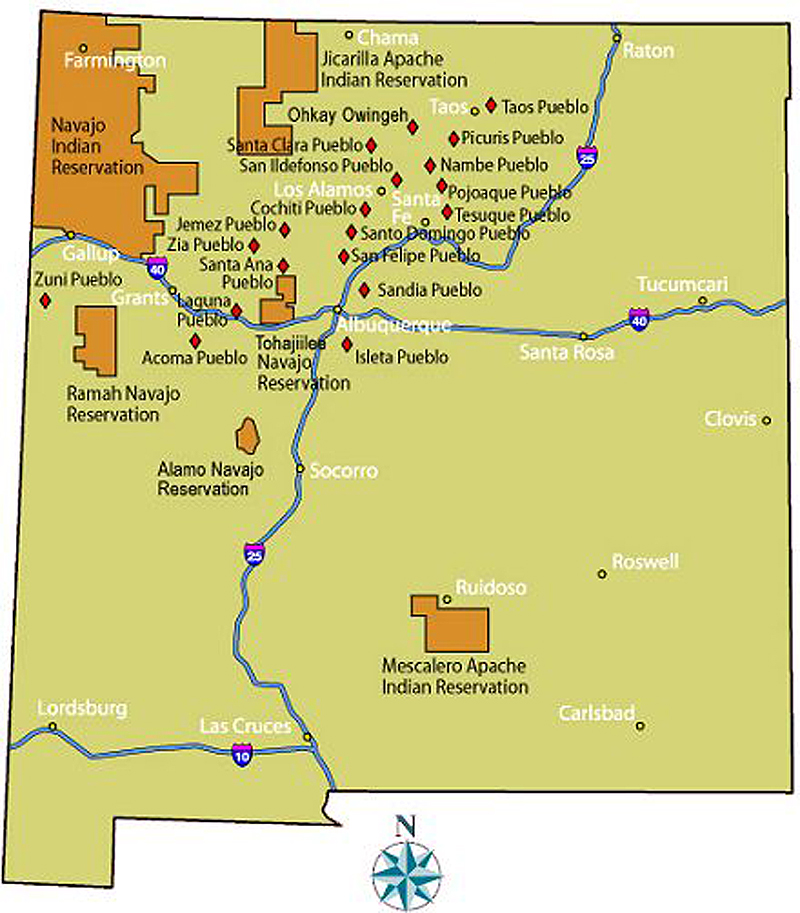
Agriculture
The region where the Pueblo people resided in present day New Mexico is a desert environment. It is very dry, arid, and water is scarce. Thus, agriculture was the basis of society and how they went about their daily lives. The pueblo people revolved around the staple crop of corn. However, they also planted gourds and melons during harvests too. The harvest was a communal effort that men and women participated in. The local “cacique” or chief would be tasked with watching the sun to tell the people when to start planting the crops. The Pueblos created vast irrigation systems along the major rivers in New Mexico. The foundation for the Pueblo being successful in their agriculture began with their ancestors, the Anasazi. The Anasazi were known for agricultural development, paving the way for the Pueblo to invent irrigation systems, proving just how intelligent they truly are. These irrigation systems are what allowed them to survive the harshness of the desert, and also this is how historians have identified these groups of people that resided there.
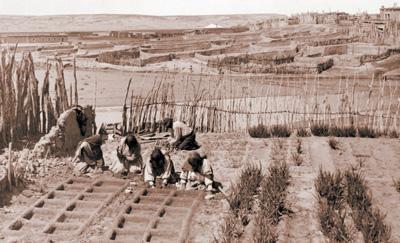
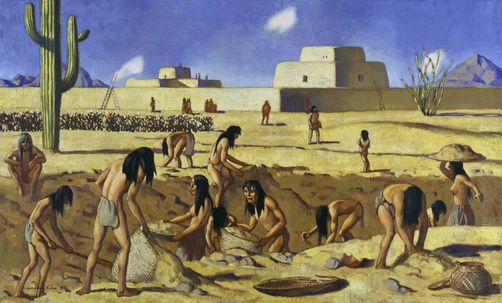
Gender Roles
Pueblo society had relatively equal roles between men and women. Their lives revolve around the harvest and all hands on deck were required for this to be successful. There are however some differences between eastern and western pueblo gender roles. In the east the society tended to be more matriarchal. The women were sometimes “caciques” and would have control over many men for the harvest. Often in the east women would be in charge of the land and control those who work on it. However, there really wasn’t ownership of the land as it was communal. Private land did not really exist in this society. In the west the story is a bit different. Men were more dominant, but women still had very important roles. They would help with the harvest or have large gardens they would tend to to feed their families. In both the east and west women could make advances towards men for courtship and often were the ones doing this. Also, they had the ability to separate from men they were tied down with relatively easily. Furthermore, they could deny courtship however they may be reprimanded by their fathers or other dominant male figures in their lives.

According to the Babcock article, Pueblo women potters represent stability as they work to form and mold pottery. This article hits on the fact that Pueblo women are often viewed as walking around in long dresses with pots on their head, and in some ways, this has become their symbol. At least the symbol that anyone who is not actually in Mexico sees. However, the irony is that in reality, they most often did not look like this. This is just how other cultures tended to view them. This article makes some interesting points as it compares the pottery to the women of this culture, insinuating that there are comparisons to be made between the two, marking them as “products of desire”. While it may seem a bit disrespectful to compare women to pottery, I do not think that was the intention. The author is very keen on letting us know how important the woman’s role in society is. As I stated earlier, she is the sign of stability and reproduction. It is obvious that communities could not last without women. I love how Babcock states that women “give life to everything they touch.” When we stop and think about this, it really is true! The women of this culture fed the men and kept them healthy and they also brought new life into the world, allowing community to expand. Essentially, their role was to keep society growing while men supported them by hunting and farming.
Society & Leadership
The society revolved around harvests so the leadership roles were based around this as well. The “cacique” would watch the sun waiting for the harvest and tell his workers when to start planting. There was a class of priests as well that were charged with the task of pleasing the Kachina gods as well as blessing the lands for good harvests and rain. The priests would let the people know what the gods were feeling. They had a large role in the community by upholding the beliefs system and keeping people motivated through the harvest season. Essentially, the priests were the highest “caste”. Then there were the local “caciques” that had the blessings for a higher role by the priests. Then there was the working class that harvested, collected water, and built things for their society. Even though there was a clearly defined society here it was very egalitarian. It was very communal and the idea of private property did not exist to these people.
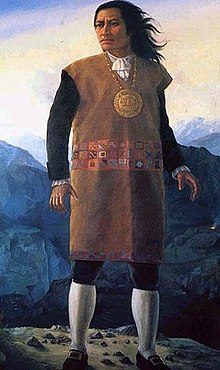
Cosmology
The Pueblos had a complex belief system with a creation story as well as beliefs that gave meaning to their natural environment. The Pueblos believed in the idea of the “spider grandmother” (Gogyeng Sowuhti). This deity was seen as a good thing and would bring these people medicine, technology, or good tidings. This being could take the form of a woman or a common spider. Along with this being there were many “Kachinas”. There were possibly hundreds of Kachinas that described the water, wind, earth, fire, etc. The Pueblos used them to explain natural phenomena as well as supernatural occurrences. In their creation story the “spider grandmother” created the Earth with “Tawa” the sun god. From their creation all other beings populated the land. The “Kachinas” arrived when man first came into existence and populated the land. The “Kachinas” helped humans develop their society in many ways until they stopped worshipping them then they returned to the “underworld”. The main “Kachinas” or gods that the Pueblos worshiped was the sun god “Tawa” and the harvest god “Patung”. Corn mattered so much to these people that they believed it to come from a deity and literally make up their bodies. The Pueblos also believed that the gods lived in the rivers so this gave even more significance to protecting the water supply.
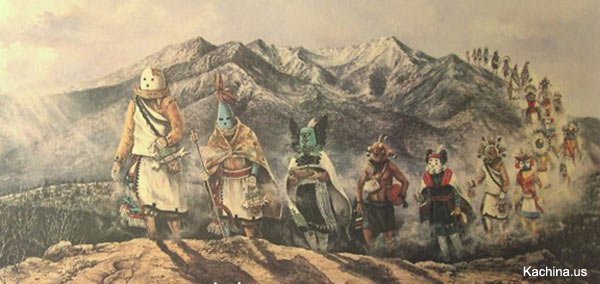
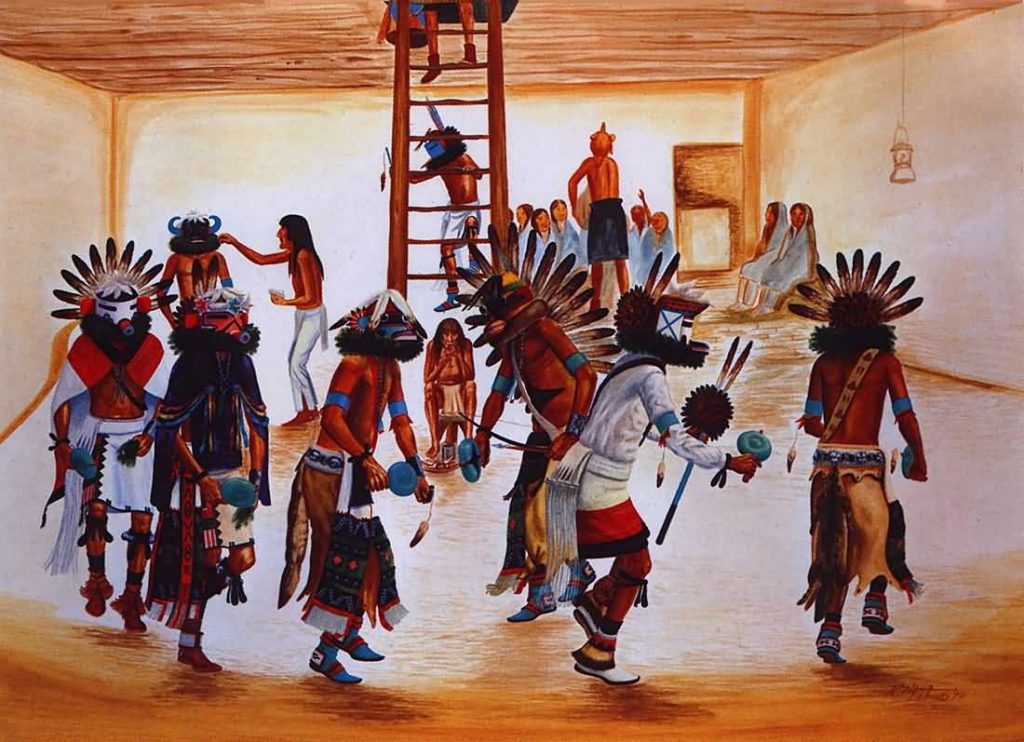
Bibliography
Anderson, Frank G. “The Pueblo Kachina Cult: A Historical Reconstruction.” Southwestern Journal of Anthropology 11, no. 4 (1955): 404-19. http://www.jstor.org/stable/3628915.
Babcock, Barbara A. “Pueblo Cultural Bodies.” The Journal of American Folklore 107, no. 423 (1994): 40-54. doi:10.2307/541072
Danver, Steven, “Pueblo” in Native People of the World: An Encyclopedia of Groups, Cultures, and Contemporary Issues. ed. vol. 2. Armonk, NY: ME Sharpe, Inc., 2013
Wittfogel, Karl A., and Esther S. Goldfrank. “Some Aspects of Pueblo Mythology and Society.” The Journal of American Folklore56, no. 219 (1943): 17-30. doi:10.2307/535911.
September 19th, 2019 at 4:58 pm
I worked on the Tarascan group, and I see a lot of similarities and difference between the two. One difference I found particularly interesting was the different geographical choices each group chose to live in. The Tarascans made it a point to chose the dense forests to stay cooler and out of the intense heat. The Pueblo people however, decided to create devices that broke the code to living in the deserts. A similarity is the dancing rituals. I talked a lot more about the dancing aspect of it, but it shows the cultural importance of dance and music.
September 23rd, 2019 at 2:17 pm
The Pueblos and Totonacs have a similar creation story in that the first humans were created directly from maize. That is why maize was such a staple in not only harvest but was also a part of Totonac religious ceremonies. The Totonac would perform cannibalism and human sacrifice in the hopes of a good harvest as well as after a bad harvest to prevent further bad harvests. The water aspect of Totonac religion was not as highly worshiped as it is the the Pueblo cultures as the area surrounding the Pueblo was much more reliant on water as they are in more arid environment compared to the rain forest of Central America.